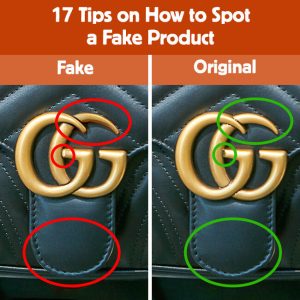Many people assume that everything in their wardrobe is authentic, but the reality is that counterfeit goods are everywhere, especially when it comes to popular and high-demand brands. Knowing how to spot the difference between genuine and fake products is essential to avoid being fooled.

Take Nike sneakers, for example. Authentic Nike Air shoes have a texture and firmness that counterfeit versions cannot replicate due to differences in materials and manufacturing processes. The leather on real Nikes feels stiffer, and the overall symmetry is precise. If your sneakers appear uneven or poorly aligned, they may not be the real deal.
Fila tennis shoes also have some telltale signs. On genuine Fila shoes, the stitching on the letter “F” may look slightly irregular, which is normal. However, if the top lines of the “F” stretch too far and nearly touch the logo’s surrounding square, it’s likely a fake. Check the holes in the toe cap—originals have evenly spaced holes. Also, compare the logos on the tongue and heel. Originals will match, while counterfeits often use different logo patches.
Burberry scarves are known for their well-defined lines and thick, high-quality fabric. The fringes won’t fray easily, and the brand label should be in all capital letters, listing the country of origin and scarf composition. Anything less is a red flag.
When it comes to Gucci bags, look closely at the two “G’s” in the logo. The font should be sleek with oval-shaped curves, not pointed or thick. Uneven stitching or mismatched thread colors are signs of a counterfeit. Authentic Gucci bags are impeccably stitched.
Supreme sweatshirts are commonly imitated, but original versions always have two dark red labels on the collar—one with the brand name and a circled R, and the other stating “Made in Canada.” Inside, there should be a warning not to iron the sweatshirt. Embroidered logos on authentic sweatshirts will be evenly spaced, and if turned inside out, a fine white mesh is visible behind the logo. Supreme uses flat laces with neatly finished ends—anything different suggests a fake.
Adidas Yeezy shoes are often counterfeited, but a few details help you tell the difference. Authentic pairs have irregular side wave patterns and a more curved tongue. The Adidas logo inside should be identical in both shoes. Uneven logo sizes or amateurish interior stitching point to a knockoff.
Toms espadrilles are another target for counterfeits. Authentic ones have non-removable insoles sewn directly into the shoe. The back logo should show balanced, square-shaped letters—fake versions often have pointed, uneven letters, especially the “O.” Excess glue on the sides is also a clear giveaway.
Michael Kors bags come with cream-colored labels that include the product’s serial number, color, material, price, and barcode. Authentic hardware—like clasps, rings, and fasteners—will be engraved with the brand name. Plus, real bags are made from dense materials that won’t lose shape during shipping.
Guess bags made from synthetic materials are often passed off as genuine. Press your finger into the material—if wrinkles don’t disappear, it’s not leather. Check the inside lining—original Guess bags use visible, soft lining, while fakes may have thin or no lining. Metal details should be smooth and shiny, not dull or scratched.
With Guess watches, authentic models use high-quality straps made of metal, silicone, or natural leather. If it smells bad, is discolored, cracked, or uneven, it’s probably fake. On the back, genuine watches are engraved with the Guess logo, the word “steel,” and “Japan Movt,” referencing the use of Japanese movement mechanisms.
Hermès bags are highly sought after and therefore commonly counterfeited. Inspect the printing inside the bag—the French accent on the letter “E” should be smooth and elegant. If the letters “F” and “R” in “France” are merged, it’s a fake. The stitching should be flawless and sophisticated—uneven or bulky stitches suggest it’s not genuine.
Lacoste polo shirts are famous for their green crocodile logo, which should have clearly defined eyes, teeth, and limbs. The tail runs parallel to the back. Men’s shirts have a red size number on a white tag, while women’s have a number “2.” Mother-of-pearl buttons with two holes and no writing are unique to Lacoste. Fakes often use four-holed buttons. Also, men’s polos have 6-inch side slits at the hem, which are not found in women’s shirts.
Balenciaga sneakers have a unique bump on the heel that fakes often lack. The structure of counterfeit shoes is weaker, and the front curves more than in authentic ones. On the back, original branding is perfectly centered and evenly sized, while fakes show mismatched lettering.
Pandora bracelets are often counterfeited, but real ones are made with a blackening technique that gives the silver a dull tone. The bracelets keep their shape and have precise striations. The clasp, which is about the same size as the charms, features the Pandora logo with a crown over the “o.” Inside the clasp, there’s a four-head clover screw mechanism and an engraving with the letters “ALE” and the metal’s purity. Charms made of Murano glass should be flawless—no cracks or bubbles. The material is also stamped with “S” for silver or “G” for gold.
Levi’s jeans can be identified by their distinctive back pocket design—a bow or diamond arch—and orange stitching. Many fakes use white thread. The red label on genuine Levi’s reads “Levi’s,” whereas some counterfeits only have the “R” symbol.
Timberland shoes have a caramel-colored sole that’s slightly transparent. The logo is printed near the heel and is clean and consistent. The eyelets are hexagonal with rounded edges—men’s models have seven, and women’s have six. All the seams are white and should run perfectly parallel.
Nike T-shirts also get copied a lot. Check the swoosh logo’s angle and shape—fakes often get it wrong. Inside labels should be free of spelling errors, and original Nike shirts usually have multiple sewn-in tags, unlike fakes, which often only have one.
Have you ever bought a counterfeit product without realizing it? Knowing these key details can help you avoid making that mistake again.





